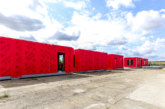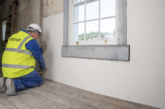Education is one of the few sectors with established guidance on the acoustic performance of buildings. However, interpreting these requirements can be complex. Here Adrian Whitefoot, Technical Services Manager at Kalzip, looks at the design considerations and performance criteria aligned to legislation requirements.
The importance of acoustic performance in an educational environment is essential. Breaches of excessive noise from hallways, surrounding classrooms and external sources can significantly reduce the attention span of students, the same can be said of sound reverberation within the classroom. Research over the past few decades has shown a correlation between poor academic results and poor classroom acoustics, confirming that children with any degree of special needs suffered with their development.
With the legislation being so complex, and the interpretation of the terminology presenting certain challenges, it is certainly advisable to partner up with a true industry expert that can help to guide the specification and installation of acoustic enhancing products to not only meet the requirements, but to ensure the aesthetic qualities are achieved.
Building Bulletin 93 provides guidance on the acoustic performance required for educational buildings. These regulations were drawn up to address the issue of poor acoustic design and performance in the classroom. The upper limit for indoor ambient noise in a nursery, primary and secondary school rooms is set at 35dB for a new building and 40dB for refurbished buildings, however this does differ from room to room. Music ensemble rooms, recording studios and teaching spaces have an upper limit of 30dB for a new-build and 35dB for a refurbishment.
Noise transmission
Airborne and impact noise can be transmitted from a variety of sources — particularly in a school setting. Playgrounds, traffic and noise pollution from adjoining classrooms and corridors all contribute to nuisance noise, and multi-storey schools suffer an even bigger impact.
There are specific points to consider when designing within the current legislation to achieve adequate sound insulation. Weak elements must be identified, for example, inadequate glazing or doors must be replaced with ‘better’ materials. Any partitions between sensitive spaces should continue beyond the ceiling to the structural soffit or roof layer to ensure noise does not pass above it.
The mass of materials is another consideration for internal sound insulation, transmission of airborne sound across a solid wall or a single skin partition will obey what is known as the mass law. In principle, the law suggests that the sound insulation of a solid element will increase by approximately 5 dB per doubling of mass.
Sound insulation
Sound reverberation is another key aspect to consider when designing educational facilities and spaces. Poor sound insulation can generate a noise issue from within the classroom itself, as noise becomes distorted and difficult to understand. The objective of this is to achieve a suitable reverberation time (RT) to enable clear communication between students, clear communication from teacher to student and to ensure that classrooms designed for with acoustic performance in mind are not affected detrimentally.
The acceptable reverberation time differs depending on the intended use of the classroom, for example, the acceptable level for a nursery classroom is ≤ 0.6 for a new-build and ≤ 0.8 for a refurbishment, whereas a secondary school would only need to achieve ≤ 0.8 and ≤ 1.0 for a new-build and refurbishment respectively. For a full table of reverberation times take a look at Building Bulletin 93.

Acoustic performance solutions
Kalzip Roof Systems can be used successfully in buildings where acoustic performance is an important issue. Due to the built-up nature of the system, it offers great flexibility. Various materials such as differing densities and types of insulation, rigid boards, flexible membranes and dampening membranes can be added to the roof build-up to give appropriate sound insulation and perforated liners and structural decks can be used where sound absorption is important. The reduction of noise from rainfall can also be enhanced with Kalzip Roof Systems when considering dampening membranes, such as the Kalzip anti-drumming membrane.
The buildings where Kalzip Roof Systems have been used successfully include airports, stadia, and schools; commercial, industrial and residential developments. Each of these has its own acoustic requirements, which further illustrates the requirement of partnering with true industry professionals.
Legislation surrounding everything from sound insulation to energy efficiency of buildings is being addressed by the Government to ensure that best practices are being adhered to. Acoustic performance for educational buildings is a top priority, and the students and staff that work within them must be considered when it comes to the design of learning spaces.










